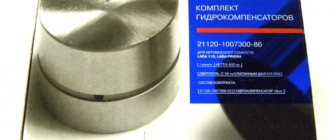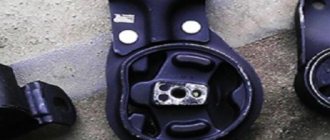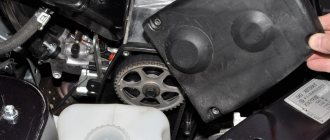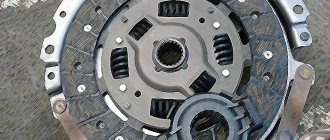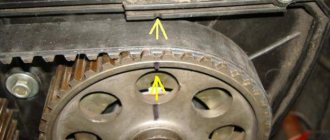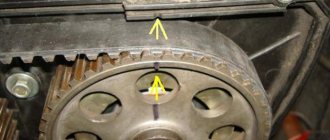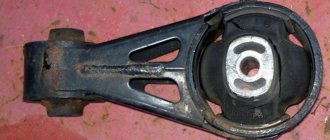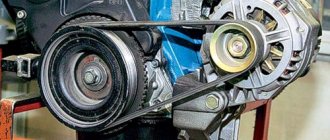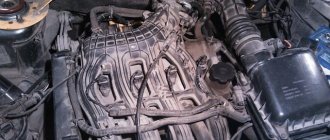Hydraulic compressors, or hydraulic valve pushers as they are also called, are designed to automatically adjust their thermal clearances. Simply put, they are a kind of gaskets between the camshaft cams and valves, capable of changing their thickness. The hydraulic compensator consists of a cylindrical body, as well as a special plunger consisting of a bushing, a spring and a ball valve. Their use on the VAZ-2112 engine makes it possible not to periodically check thermal clearances, as on the 2108 engine (valve adjustment) .
The replacement of hydraulic compensators is described and shown in detail and “up close” in the video below:
Replacing hydraulic compensators on a VAZ 2112
Using a 10mm wrench, unscrew the four nuts securing the plastic shield. After removing the oil filler cap, remove the plastic shield.
Using a 13mm wrench, loosen the nut securing the generator to the mounting plate.
By turning the adjusting bolt counterclockwise with a “10” wrench, we loosen the tension of the generator drive belt. We remove the belt.
Remove the receiver and engine intake manifold. We close the openings of the intake manifold with covers to prevent foreign objects from getting into it.
Remove the right wheel and the plastic shield of the engine compartment. Using the “19” head, turn the crankshaft clockwise by the pulley mounting bolt.
Rotate the lower pulley until the mark on the camshaft toothed pulley aligns with the installation tab on the rear timing cover.
Use a 17mm wrench to loosen the fastenings of the camshaft pulley. Remove the timing belt.
The marks on the timing belt guard must match the marks on the pulleys. Completely unscrew and remove the camshaft pulleys.
Using a 8mm socket, unscrew the 15 bolts securing the cylinder head cover.
Next, use the same “8” key to unscrew the 20 bolts securing the camshaft bearing housing.
Remove the camshaft bearing housing.
We take out the camshafts with oil seals.
Applying a magnet or magnetic screwdriver to the end of the hydraulic pusher, remove it from the cylinder head socket.
We take new hydraulic compensators and...
... install them in the nests.
Lubricate the bearing journals and camshaft cams with machine oil and place the shafts in the cylinder head supports. To distinguish the intake camshaft from the exhaust camshaft, a belt is made on the intake shaft near the first journal.
Tighten the nuts in the sequence shown in the photo until the bearings touch the cylinder head.
We install and tighten the valve cover, install the camshaft pulleys and timing belt. We assemble the remaining parts in reverse order.
A hydraulic compensator (HC) is a part of the engine block head, the purpose of which is to automatically adjust the thermal clearances of the engine valves in order to prevent the formation of gaps between the valves and the camshaft cams.
Causes and consequences of malfunction of VAZ 2112 hydraulic compensators
Failure to promptly change the oil and filter, or adding low-quality, contaminated or used engine oil to the engine lubrication system can lead to the following consequences:
- Increasing clearance in the plunger , which causes increased oil leakage from the bushing under the plunger. As a result, the hydraulic compensator does not have time to select gaps in the timing belt, and characteristic knocking noises appear.
- Wear or clogging of the ball valve , leading to an increase in oil leakage from the cavity under the plunger, resulting in loose closure, leading to wear of parts and their premature failure.
- Wedging of the plunger pair completely disables the hydraulic compensator. Loads occur in the timing belt, leading to wear and damage to the camshaft cams.
Tips for replacing hydraulic lifters on a VAZ 2112
In some cases, valve clogging can be eliminated by flushing the hydraulic tappets. All other faults, as a rule, require replacement of hydraulic compensators.
The successful replacement of VAZ 2112 hydraulic compensators will be indicated by:
- improved timing gap adjustment;
- elimination of extraneous engine noise;
- implementation of smooth acceleration of the car (without failures at low speeds);
- reduction of engine vibration.
It is necessary to change the hydraulic pushers as a set; if this is not done, and only change the hydraulic valves that are knocking, there is no guarantee that after a while others will not start knocking and everything will have to be redone again.
To perform the work of replacing hydraulic compensators, the following tool is required:
- a set of keys;
- magnetic screwdriver;
- jack;
- degreaser and sealant for engine block;
- set of hydraulic compensators from VAZ-2112 (16 pcs.).
The price of VAZ 2112 hydraulic compensators from LADA with article number 21120100730000 will be about 200 rubles per piece. Total 3200 rubles per set.
The cost is indicated for spring 2022 in Moscow and the region.
The hydraulic pumps are knocking and the “OIL” light is on
Required spare parts
Article numbers 2112-1007300-01 and 2112-1007300 indicate hydraulic pushers manufactured by AvtoVAZ - this is the catalog number. They need to be purchased for repairs. The price of the set is about 3,300 rubles (per piece – 220 rubles). You can also buy spare parts with article number 420007310 INA. They are suitable for replacing VAZ 2112 hydraulic compensators (16 valves), but the price of the set is higher - up to 2,700 rubles (per piece - 280 rubles). Another analogue is Herzog HL0 7300. Price 2700 rubles. The compensator Master-sport 2112-1007300-SET/16/-MS is also recommended for installation on VAZ 2110, 2111, 2112.
Replacing hydraulic compensators on VAZ-2110, 2111, 2112
Hydraulic compensators (hydraulic pushers) of valves are used to automatically adjust thermal valve clearances. In essence, they are a kind of gaskets between the camshaft cams and valves, capable of changing their thickness.
Their use in the engine makes it possible not to systematically adjust thermal clearances.
The design of the hydraulic compensator consists of a cylinder-shaped body and a plunger, including a bushing, a ball valve and a spring.
The principle of its operation is as follows. When the cam turns its blunt side towards the pusher, a gap appears between them. At this time, the spring-loaded plunger rises up, closing it, and the oil enters the plunger cavity through a channel with a ball valve.
Device
What to do if valves or hydraulic compensators on a VAZ 2112 16 valves are knocking? Before answering this question, it is necessary to understand the structure of the hydraulic compensator, which mechanics often abbreviate to “hydric”. It is from the peculiarities of its structure that the reason for some knocks follows.
The hydraulic compensator itself consists of a cylindrical piston, whose bottom receives the force from the camshaft pusher. There is a plunger located inside it. With its help, force is transmitted from the camshaft to the valve stem. The plunger moves quite freely in its seat. This is necessary to ensure a thermal gap. When the engine is running, the camshaft cam pushes the piston, which opens the valve through a plunger. The thermal gap is adjusted using oil supplied to the head under pressure. Accordingly, adjustment occurs by changing the pressure. To avoid oil leakage from the hydraulic valves during parking, a ball valve is used.
Malfunctions of hydraulic compensators
The main indicator of failure of hydraulic compensators is their characteristic knocking sound. It is he who signals that it is time for a replacement. There may be several reasons for this:
- spent resource;
- premature wear of the plunger pair due to wear products entering the device;
- clogged oil supply channels.
If the hydraulic pushers have become unusable after working for the required period, it means that the car owner paid maximum attention to the engine.
But the other two cases are a consequence of the use of low-quality, inappropriate oil, its untimely replacement, malfunctions of the oil pump or other elements of the lubrication system.
The hydraulic compensator will work ideally only when its internal space is completely filled with oil. Otherwise, dynamic loads will gradually destroy it and they begin to knock.
Do-it-yourself replacement of hydraulic compensators
The process of replacing hydraulic compensators itself is simple, but you will have to work hard to implement it, because it involves dismantling the valve cover and camshafts. The order of work is as follows.
1. Place the car on a flat surface and secure it with the parking brake.
2. Raise the hood of the car, disconnect the negative terminal.
3.Remove the engine protective cover.
4. Dismantle the receiver. We plug the inlet holes with a clean rag to prevent foreign objects and dirt from getting inside.
5. Dismantle the ignition module and crankcase ventilation hose.
6. Unscrew the bolt fixing the bracket for the injector power wires.
7. Unscrew the 15 bolts securing the cylinder head valve cover and dismantle it.
8.Having removed the cover, we check the condition of the hydraulic compensators by pressing on them from above with a screwdriver. A working hydraulic pusher should compress with great force. If significant effort is not required to compress it, the compensator is faulty.
9.Remove the drive gears from both camshafts.
10. Disconnect the oil pressure sensor connector.
11. Unscrew the 20 bolts securing the bearing housing.
12.Unscrew the nuts securing the rear shaft support bracket.
13. We dismantle it together with the bearing housing along with the spark plug guides.
14. We take out both camshafts (put them back according to the marks)
15.To remove hydraulic compensators from their sockets, use a magnet.
16. We remove the old hydraulic pushers. We install new ones in their place.
17. Installation is carried out in the reverse order, do not forget to set the camshaft marks.
18. We get rid of sealant residues at the joints with the cylinder head. We take into account the tension of the head mounting bolts.
19. Before assembly, apply special Loctite sealant to all head joints.
The result of the work
Having completed the installation work, we check the operation of the engine. Immediately after starting, the engine may work, making extraneous sounds in the form of clattering or tapping. They indicate that the hydraulic compensators need to be pumped, i.e. fill with oil, expelling the air.
To carry out this procedure, start the engine and run it for 5 minutes at 2500 rpm. After this, go to idle speed and wait 30 seconds. Next, turn off the engine and wait a minute.
Next time you start, listen again. If the sound does not disappear, repeat the procedure. Usually after 3-5 such pumpings the extraneous sounds disappear.
Tell me who changed the hydraulics, I bought a complete set of 16 pieces, they are 8 in a package, so you won’t sell some of the hard ones, but the other 8 soft ones are worth installing or not from INA
In general, hydraulic compensators should be rigid and definitely should not be pressed down by hand without effort, unfortunately I don’t know how soft they are; if they are pressed too easily, they will knock.
Why tighten the cylinder head bolts? As I understand it, the cylinder head does not need to be completely removed.
I have a knocking noise, I also filled it with oil and it keeps knocking, can I fix it somehow?
How much do hydraulic compensators cost?
Tell me when you start the hydraulics when they are cold, they knock, everything seems to heat up normally, then again a quiet knock turns up the speed, everything is quiet. What could this be?
They started knocking after I filled it with Shell Helix, before that I drove Mobil-1 and had no problems. Now the campaign will have to change.
Important points
- As mentioned above, the cause of knocking on compensators may be poor-quality oil. If you plan to change only the oil without replacing the hydraulic compensators, then you will need to stock up on engine flushing fluid. The problem is that purchasing really high-quality liquid is not so easy now.
- If there is no normal fluid, the engine will have to be flushed manually. To do this, you need to remove all hydraulic compensators from their sockets and wash them in kerosene. During this operation, the most important thing is not to mix up the parts, that is, each compensator will need to be placed where it was before washing.
- Removing the hydraulic compensator from its socket is not as simple a task as it seems at first glance. It is recessed deep enough and nothing can pry it off. It is best to remove these parts from the engine using a magnet.
- Before replacing hydraulic compensators, each of them should be checked: perhaps some will still serve. To check, you just need to press on each compensator with your fingers and try to push it into the socket. If this required significant effort, the part will still serve. If the hydraulic compensator falls into the socket very easily, it must be replaced.
- After replacing the compensators and starting the engine, you should not expect that the knocking will disappear instantly. You need to let the car run at high speeds for 5-8 minutes. During this time, the oil will reach the sub-plunger space of the hydraulic compensators and the knocking will disappear. The same applies to the situation with a simple oil change - the new oil must be given time to reach the hydraulic compensators.
The most important thing when replacing hydraulic compensators is not to make hasty decisions, since in some cases you can do without replacement at all. And if you still have to change it, it is important to follow the instructions and be sure to pay attention to the important nuances of the process outlined above.
vote
Article rating
What malfunctions most often occur with hydraulic compensators?
If you drove earlier VAZ models, then you remember the unpleasant knocking sound that signaled a problem in the engine valve system. In model 2112, the engine uses the same extraneous noise to notify the owner about a malfunction of the hydraulic compensators. Typically, their failure occurs for the following reasons:
- development of their resource;
- engine wear products getting inside the pushers;
- untimely oil change, which led to clogging of its supply channels.
If replacement of hydraulic pushers was necessary at the end of their service life, then this is direct evidence that the car owner pays sufficient attention to engine care. First of all, VAZ-2112 owners need to:
- observe oil change intervals;
- do not fill the engine with low-quality lubricating fluid;
- monitor the serviceability of oil systems;
- Check the oil level regularly.
For ideal operation, the hydraulic tappet must be completely immersed in oil. This will reduce the dynamic load on this engine element and prevent its failure. An insufficient amount of lubricant leads to the fact that the hydraulic pushers are gradually destroyed and their replacement becomes necessary.
Types of knocks
We've sorted out the structure, now let's look at the causes of knocking and their varieties. After all, knocking can happen in different ways and some of the sounds are quite harmless:
- The knocking noise appears upon startup, but disappears almost immediately. This is a common phenomenon characteristic of “hydrics”. It occurs due to ball valves remaining open, oil gradually leaking out of them. During engine operation, the amount of oil is restored. Actually, you don’t need to do anything here. This is a normal technical process;
- The knocking is heard constantly, but disappears when the speed increases. This problem can occur if the ball valve is faulty, or if the part is contaminated with low-quality oil;
- Knocking occurs only on a hot engine, in case of increased wear of the hydraulic valve. When cold there may be no knocking;
- If knocking is heard only at high speeds, but not at low speeds, then the reason is in the oil. Check the oil level and condition. If the level is higher than usual, the crankshaft whips up the oil during operation, and a kind of foam forms in it. It gets through the oil intake into the cylinder head and, accordingly, into the hydraulic compensator, the operation of which is disrupted. If the level of lubricant is too low, it simply does not reach the hydraulics. In both cases a knock will be heard.
What to do? The most common cause of knocking is a lack of oil. Perhaps, after adding a fresh portion of lubricant, your car will stop rattling. You can also identify the knocking hydraulic valve and clean it. If all this does not help, then the faulty part should be replaced.
Approximate price of hydraulic compensators
Unlike foreign-made cars, parts for the VAZ-2112 are affordable. In most auto parts stores for domestic cars you can find a set of hydraulic compensators for a sixteen-valve engine at a low price - about two thousand rubles. Before purchasing, carefully examine each pusher to avoid purchasing a defective part.
Among manufacturers of spare parts for VAZ-2112 engines, the INA brand occupies a leading position, but it is very often counterfeited. In order to make the right choice, watch a video in advance about the features of branded hydraulic pushers. Pay close attention to how much a set of pushers costs, since a high-quality spare part cannot be cheap.
Let's summarize
The operation of installing new hydraulic compensators is quite simple; even a beginner who knows how to handle the tool can handle it. It should be understood that new parts also tap first. But this shouldn't last long. If the sound does not stop, you need to determine the cause. In order not to carry out the procedure often, monitor the quality of the oil used.
See this video for the sequence of replacing hydraulic compensators on the VAZ 2110 and other models:
Source
How to replace hydraulic pushers
Replacing the pushers is not always necessary to eliminate knocking in the engine; in some cases, you can do without it by following a few simple steps:
- remove the gas distribution part cover;
- turn the crankshaft (you need to open the valve that is knocking);
- move the contact points using a special spring;
- put the cover back in place;
- test run the engine.
Remember that any work must be carried out after stopping the engine for half an hour. If the problem of valve knocking on the VAZ-2112 is not solved by the procedure described above, then it is best to replace them.
It is best not to change the hydraulic pushers individually, but to immediately buy a set of 16 valves and carry out a comprehensive repair. Even a beginner can carry out the replacement using the following instructions:
- Remove the plastic cover.
- Close the intake manifold caps and remove the receiver.
- Remove the ignition module.
- Using a 10-mm open-end wrench, loosen the injector conductors and disconnect them.
- Take the 8 socket and remove the 15 bolts from the valve cover. Remove it and dismantle the cylinder heads.
- Use a metal rod to check how efficient the pushers are. To do this, you just need to click on each compensator. This test can only be carried out when the camshaft knuckle is turned to the hydraulic compensator with its blunt side. A damaged pusher is pressed very easily, without effort.
- Once you have confirmed that the pushers are faulty, you can begin further work on replacing them. To do this, remove the toothed pulleys from the camshaft.
- Disconnecting the oil pressure sensor.
- Using a 8mm socket, unscrew the housing that hides the camshaft bearings. It should have 20 bolts.
- A rod is attached to the rear engine mount bracket. You need to remove the bolt that secures this connection, and then dismantle the bracket itself
- Next, remove the camshaft housing, these mechanisms themselves, seals and spark plug tubes.
- Remove the plugs from the camshaft housing and cylinder head. Now you can use a magnet to remove the compensators and replace them with new ones. Assembly is carried out in reverse order. Before doing this, it is necessary to clean the cylinder head and bearing housing from old grease, and also lubricate the journals and camshafts of both camshafts with clean engine oil.
It is best to watch the video instructions before starting work. With its help, it will be much easier for you to replace the pushers. Only visual instructions will help you properly repair the valve system.
System structure
Hydraulic compensators produced by AvtoVAZ
The hydraulic compensator is a cylindrical piston that transmits the force of the camshaft pusher. The internal part has a plunger that transmits force to the valve
.
This is what provides the thermal gap. In order for the valve
to open, the piston pushes the camshaft cam, which in turn pushes through the plunger, which acts on the valve.
The thermal gap is adjusted by oil under pressure. The ball valve
prevents oil from leaking.
Diagnostics of hydraulic compensators
- In order to check the hydraulic compensators, it is necessary to dismantle the valve cover.
- Next, the crankshaft is brought to a position where the compensators are not affected by the cams.
- The next step is pressing on the pistons. If the piston is in good condition, it moves downwards under great force. If the piston stops, then the plunger is jammed, but if there is a lack of oil, then it will go down without any problems.
Method for eliminating knocking
Of course, hydraulic compensators cannot be repaired, so they must be replaced.
Some car enthusiasts try to repair them, but as experience shows, it all ends with replacement after several thousand kilometers. The second factor that pushes car enthusiasts to replace them is that repairing these parts is too expensive and not economically feasible.
The reasons for the knocking of hydraulic compensators are quite simple, and their classification immediately indicates the reasons for the occurrence of this effect. The main method of troubleshooting remains a comprehensive replacement of all products.
I remember trying to install hydraulic compensators on the “six” so as not to set the valve clearances. The car immediately became dumber. A year later, during the next renovation, I removed them. And on the “twelfth” they are still working well. To avoid foam, you need to fill in high-quality oil.
I noticed that my hydraulic compensator was starting to tap, so I went to take a look. It turned out to be worn out and had to be replaced with a new one.
Sometimes you just need to change the engine oil and the knocking goes away. That is, if you change the oil at the wrong time (more than 10,000) due to dirt, let’s say they get stuck.
On 2110
16 valve after warming up the engine to 70′ there is a metallic knock or a clattering noise, and so on constantly while the engine is hot, when cold it works fine, without this clattering noise, what is the reason?
Yes, I'm sorry, the clatter appears in the cylinder head area where the camshafts are.
I changed the oil and the knocking does not go through the compensators
So I was hooked on this problem, the knocking of the hydraulics, whether it’s cold or hot, Lukoil Armotek 5-40 synthetic oil drove three thousand on it and one morning when they started bubbling it became scary, before that they knocked, but when the engine warmed up they stopped using the same oil. I consulted with familiar service technicians, like pour 500 ml of salya into the oil and let the engine run for 3-5 minutes on this mixture and drain it, then pour in the flushing oil and rinse. I thought that I should try just changing the oil and filter, like pour in cheap oil, run it, warm it up, and then fill it with a better one. I bought a Gasprom 10-40 and replaced the filter and oops there was a tapping sound like one gidriu and not loudly, I gave it 4000 rpm, it pumped everything up, everything became quiet, in the morning when it was cold there was no break at all and the rpm calmly began to luxuriate. Before changing the oil, while I was going to Mogaz, I turned the engine to 4500 the knocking seemed to subside and then appeared again at XX. I arrived at the garage at idle and it rattles, then it seems to disappear and the noise goes away again. I changed the oil and the rattling went away. While I'm driving around on 10-40 gas with a synthetic floor and a new Linux filter. Tolley oil... but only filter I don’t know. But due to the increase in prices because of this virus, hydraulics cost 5400. It’s kind of expensive. Engine 21124 with mileage 273000 without capital. Oil pressure at XX 1.5-2.0 kg with increasing speed increases. So well, this engine works and let It’s working. I’ll try to measure the oil pressure on the new oil. If anything, I’ll let you know.
Checking, washing and replacing hydraulic lash compensators in the valve drive mechanism _
Hydraulic gap compensators in the valve drive mechanism are used to eliminate gaps in the drive. The operation of the hydraulic compensator is based on the principle of incompressibility of engine oil, which constantly fills the internal cavity of the hydraulic compensator during engine operation and moves its plunger when a gap appears in the valve drive, ensuring constant contact of the rocker roller (press lever roller in a DOHC engine) of the valve drive with the camshaft cam without gap. This eliminates the need to adjust valves during maintenance.
Hydraulic compensators for SOHC and DOHC engines are fundamentally the same in design and are non-separable compact devices inserted into sockets in the arms of the valve rocker arms for SOHC engines and for DOHC engines. into the cylinder head sockets.
The operation is illustrated using a SOHC engine as an example. Different techniques for the DOHC engine are mentioned separately.
Knocking of valves when the engine is running can be caused by:
If bleeding or washing fails to restore the functionality of the hydraulic compensators, replace them, since they have a non-separable design.
First, make sure that the extraneous noise during engine operation is caused by a malfunction of the hydraulic compensators:
If the oil level in the crankcase is too low, the oil pump takes in air along with the oil; if the level is too high, the oil is agitated and churned by the counterweights of the crankshaft. When the car is parked for a long time on a slope, oil flows out of the cavities of the hydraulic compensators and oil channels, and supplying oil to the hydraulic compensators after starting the engine requires some time, during which air has time to enter the cavity of the hydraulic compensator. In all these cases, when oil and air enter the above-plunger cavity of the hydraulic compensator, the air inside this cavity will be compressed when the valve is opened and the hydraulic compensator will be underpressured, which will lead to a characteristic knocking sound of the valve mechanism with increased clearances.
